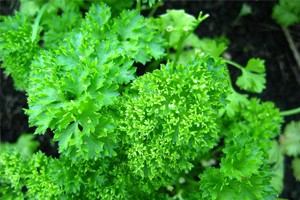Seven Great Reasons to Love Parsley
 The humble parsley leaf tucked on the edge of your plate at a diner is actually one of the most versatile and beneficial herbs known to us. Though the light, mellow flavor of parsley makes it a natural addition to foods like salads, soups, and sandwiches, this herb has a wide range of other culinary and healing uses. Parsley is also very easy to grow, which makes it a natural addition to a home medicinal or kitchen herb garden. PurMedica has collected seven interesting facts that you probably did not know about parsley.
The humble parsley leaf tucked on the edge of your plate at a diner is actually one of the most versatile and beneficial herbs known to us. Though the light, mellow flavor of parsley makes it a natural addition to foods like salads, soups, and sandwiches, this herb has a wide range of other culinary and healing uses. Parsley is also very easy to grow, which makes it a natural addition to a home medicinal or kitchen herb garden. PurMedica has collected seven interesting facts that you probably did not know about parsley.
1. Just half a cup of chopped parsley is packed with essential vitamins and minerals
This small amount of parsley contains over 50% of the daily recommended amount of Vitamin C and more than five hundred times the recommended daily minimum of Vitamin K. You will also find Vitamin A, iron, folate, copper, magnesium, fiber, calcium, and potassium in this amount of chopped parsley in addition to a small amount of B Vitamins and other minerals.
2. Parsley contains antioxidant nutrients
Like most plants, parsley is chemically complex. Scientists have identified two particular types of compounds, flavonoids and volatile oils. Flavonoids include the compounds apigen, apiin, luteolin, and crioeriol. These compounds, particularly luteolin, have been identified as antioxidants, which help prevent damage to cells caused by oxygen free radicals. Though oxygen is a beneficial molecule in many ways, some oxygen containing molecules are highly reactive and can harm cells.
The volatile oil compounds identified in parsley include eugenol, limonene, myristicin, and alpha-thujene. These compounds have been shown to inhibit the formation of tumors in animals. Lung tumors in particular are responsive to myristicin, which is responsible for activating a powerful healing enzyme called glutathione S transferase.
3. We have known about parsley and its healing qualities for thousands of years
Parsley’s healing properties were no mystery to the ancients. In fact, this plant has been cultivated for medicinal purposes for more than 2000 years; it is mentioned in ancient herbals and medical texts. Though it is native to the Mediterranean region of Europe, its hardy nature certainly encouraged its spread to many other surrounding areas. Today both flat and curly leaf varieties are valued for taste, appearance, and health promoting qualities.
4. A little bit of parsley will fix bad breath
Worried about bad breath after having lunch? Just nibble on that sprig of parsley placed on the plate. The clean, fresh flavor of the plant will help drive away the effects of onion, garlic, coffee, and other strong foods.
5. Grow parsley at home for easy access to its fresh form
Parsley can be started from seed or purchased as a plant from a nursery or garden shop. It will do well growing in a window box, in a flower pot, or in the garden. Fresh parsley yields the most nutrients, so having a plant around is a good idea.
If you would like to harvest your parsley for use at a later time, simply clip a few sprigs from the plant, wash them carefully, pat dry, and spread them out on a paper towel, cookie sheet, or other clean flat surface. Once the leaves have completely dried, collect them into a small jar for storage in your spice cabinet. Flat leaf parsley is most easily harvested and dried so if you plan to collect parsley for future use, choose to plant this variety in your garden.
6. Parsley can be used in lots of dishes
The fresh, green taste of parsley is a flavor that works well in all kinds of dishes, including:
-
Bean and vegetable salads
-
Broth-based soups and cream-based soups
-
Tapenades and other sandwich spreads
-
Pasta sauces
-
Stuffed vegetables
-
Marinades for grilled vegetables, seafood, or fish
-
A summer garden salad

